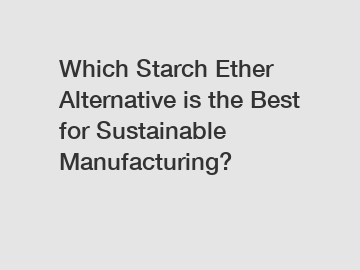Which Starch Ether Alternative is the Best for Sustainable Manufacturing?
Which Starch Ether Alternative is the Best for Sustainable Manufacturing?
With the increasing focus on sustainability in manufacturing processes, various industries are actively seeking alternatives to conventional materials. One field that has gained significant attention in recent years is the development of starch ether alternatives for sustainable manufacturing. These alternatives, derived from natural starch sources, offer a range of advantages over traditional materials. But which one is truly the best for sustainable manufacturing? Let's delve into the options and find out.
1. Modified Starch Ether: .

Modified starch ether is a popular choice for sustainable manufacturing due to its biodegradable and renewable properties. It is derived from starch, a natural polymer found in plants, and processed to enhance its stability and performance. These modifications enable starch ether to replace petroleum-based polymers in various applications, such as adhesives, coatings, and packaging materials. Their biodegradability makes them an attractive choice for reducing landfill waste, reducing pollution, and minimizing environmental impact. Additionally, modified starch ether can significantly reduce the carbon footprint associated with manufacturing processes, providing an excellent solution for sustainable practices.
2. Hydroxypropyl Starch Ether:
Another starch ether alternative gaining attention in the sustainable manufacturing realm is hydroxypropyl starch ether (HPSE). This compound offers excellent water solubility and adhesive properties, making it ideal for various applications in the construction industry. HPSE can be used as a binder in building materials like tile adhesives, renders, and cement-based composites. Its natural origin and biodegradability contribute to reducing the environmental impact associated with conventional alternatives. HPSE also possesses good film-forming properties, allowing it to act as a protective barrier against moisture, thereby enhancing the durability and stability of the materials.
3. Carboxymethyl Starch Ether:
Carboxymethyl starch ether (CMSE) is yet another promising alternative for sustainable manufacturing. It is created by modifying starch with carboxymethyl groups, enhancing its solubility in both cold and hot water. CMSE offers remarkable film-forming and emulsifying properties, making it suitable for applications in the textile, paper, and food industries. Its biodegradability and non-toxic nature make CMSE an eco-friendly choice compared to conventional materials like polyvinyl alcohol or carboxymethyl cellulose. Moreover, CMSE exhibits excellent thickening and stabilizing capabilities, reducing the need for synthetic additives and contributing to the preservation of natural resources.
4. Esterified Starch Ether:
Esterified starch ether is another noteworthy alternative that possesses exceptional potential for sustainable manufacturing. This starch ether is produced by esterifying the hydroxyl groups of starch with organic acids or anhydrides. It exhibits excellent film-forming properties, making it suitable for applications in the paper, textile, and coating industries. Esterified starch ether offers benefits like improved coating adhesion, controlled release of active components, and biodegradability. By replacing conventional materials, this alternative contributes to environmental preservation, reduced pollution, and energy conservation.
In conclusion, the search for the best sustainable manufacturing alternative to conventional materials has led to the development of various starch ether options. Modified starch ether, hydroxypropyl starch ether, carboxymethyl starch ether, and esterified starch ether all provide eco-friendly and biodegradable alternatives for applications across multiple industries. Each option possesses its own set of advantageous properties that contribute to sustainable manufacturing. The choice of the best alternative largely depends on the specific requirements of the intended application. As industries continue to prioritize sustainability, further research and development in the field of starch ether alternatives are likely to yield even more effective and eco-friendly options.
For more Self Leveling Compound Basecoat Primer, Buy Gypsum Self Leveling Compound| Kundu, Cement Based Self-Leveling Compound| High Performanceinformation, please contact us. We will provide professional answers.

Comments